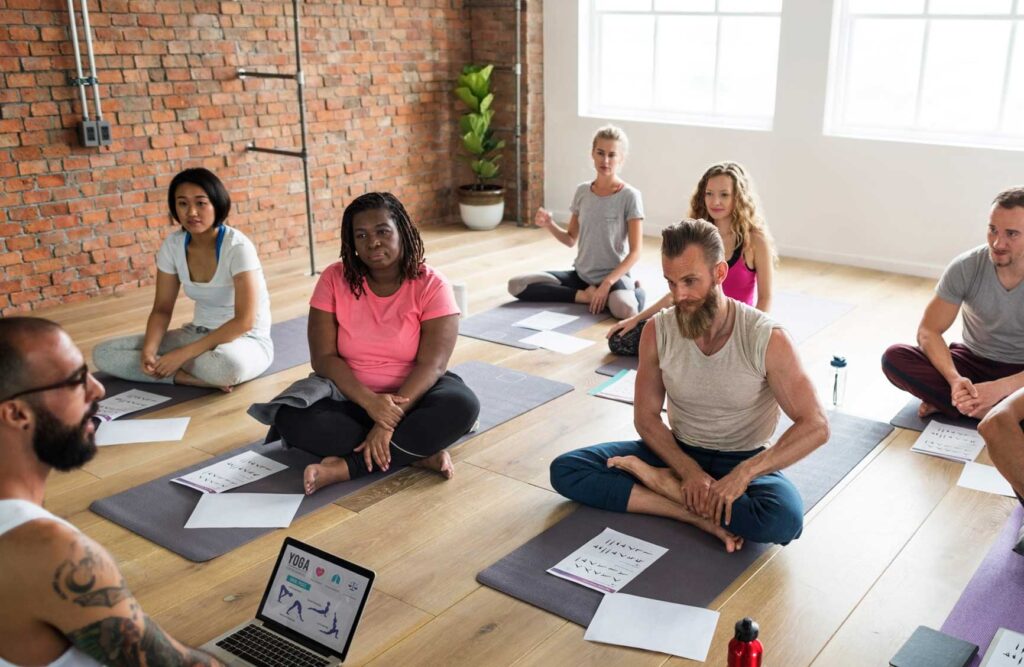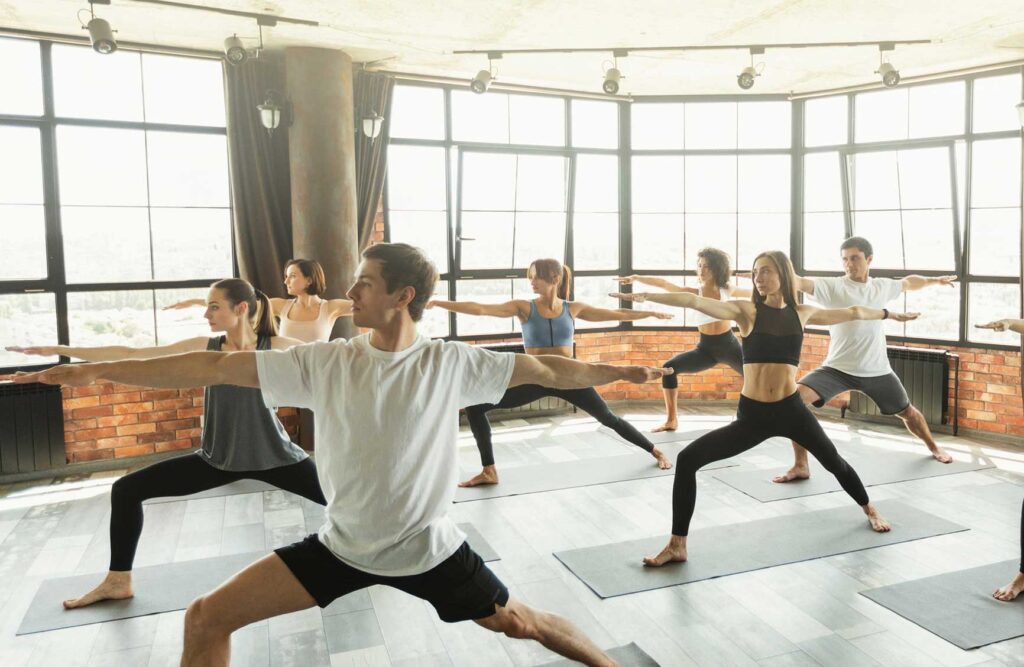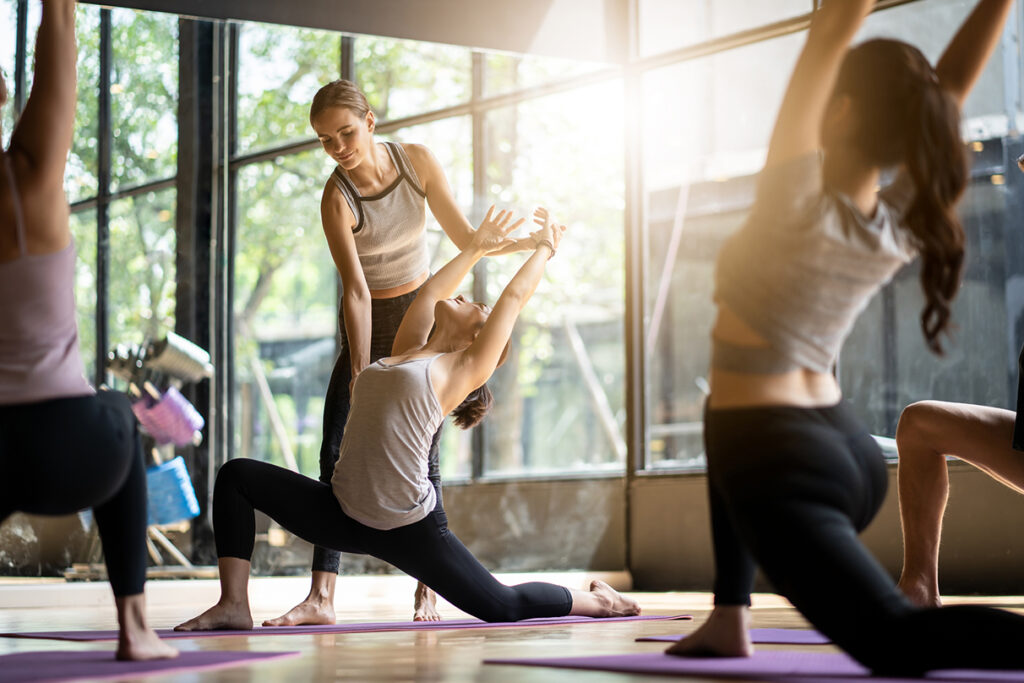Have you ever found yourself completely absorbed in a yoga class, wishing you could bottle up that feeling and share it with others? The idea of guiding a group through sun salutations or leading a restorative savasana might be calling your name. If becoming a yoga instructor is on your bucket list, you’re probably wondering how long this transformative journey takes.
The path to becoming a certified yoga instructor is both rewarding and varied, offering a range of timelines to suit different lifestyles and learning styles. Whether you’re dreaming of whirlwind intensive training or a more relaxed part-time program, this guide will illuminate the different pathways, timeframes, and factors influencing your journey.
Ready to start your journey? Manage your studio and classes seamlessly with Yoga Studio Software designed to support your growth as an instructor

The Foundations: Before You Start Training
Before you dive into a yoga teacher training program, it’s important to establish a solid foundation. While formal teaching experience isn’t always a prerequisite, consistent personal yoga practice is highly recommended.
Your personal practice serves as a testing ground for different yoga styles, allowing you to explore various postures, breathing techniques, and philosophical concepts. It’s also a space for self-discovery, where you can identify the styles that resonate with you most deeply.
Whether you’re drawn to the dynamic flow of Vinyasa, the precise alignment of Iyengar, or the meditative stillness of Yin, understanding your preferences will help you choose a teacher training program that aligns with your interests and aspirations.
Some key questions to consider at this stage include:
- How long have you been practicing yoga, and how often do you practice?
- Which styles of yoga do you enjoy most?
- What aspects of yoga resonate with you most deeply (physical, mental, spiritual)?
- What are your motivations for becoming a yoga instructor?
Reflecting on these questions will not only clarify your path toward teaching but also lay the groundwork for a fulfilling and authentic yoga instructor journey.
The Standard Route: 200-Hour Yoga Teacher Training
For most aspiring yoga instructors, the most common pathway is a 200-hour Yoga Teacher Training (YTT) program. This comprehensive curriculum is designed to equip you with the knowledge and skills needed to teach yoga safely and effectively.
What does a 200-hour YTT typically cover? You can expect a deep dive into:
- Techniques, Training, and Practice: Asana (poses), pranayama (breathing exercises), meditation, and other traditional yoga techniques.
- Teaching Methodology: Communication skills, how to structure a class, hands-on adjustments, and addressing the needs of diverse students.
- Anatomy and Physiology: Understanding the human body and how it moves in yoga postures.
- Yoga Philosophy, Lifestyle, and Ethics: Exploring the history and philosophy of yoga, as well as ethical considerations for yoga teachers.
The time commitment for a 200-hour YTT varies depending on the program format. Some schools offer intensive programs over a few weeks, while others have part-time programs spanning several months. Online YTTs are also gaining popularity, offering flexibility for those with busy schedules.
Most 200-hour YTT programs are registered with Yoga Alliance, the largest nonprofit association representing the yoga community. Completing a Yoga Alliance-registered program ensures that your training meets certain standards and makes you eligible to register as a Registered Yoga Teacher (RYT-200). While not mandatory, this credential is widely recognized and often preferred by studios and employers.
Whether you choose an intensive, part-time, or online 200-hour YTT, this training will provide you with a solid foundation in yoga instruction, preparing you to share your love of yoga with students confidently.
Advanced Certification: 300-Hour YTT and Beyond
For experienced yogis seeking to deepen their knowledge or specialize in a particular area, a 300-hour Yoga Teacher Training (YTT) program offers the next step in their yoga instructor journey. These programs are designed to build upon the foundation established in a 200-hour YTT, delving into more advanced topics and refining teaching skills.
Who is a 300-hour YTT for? This training is typically geared towards:
- 200-Hour YTT Graduates: Those who have already completed a foundational teacher training and are eager to expand their expertise.
- Experienced Practitioners: Yogis with a dedicated personal practice who want to deepen their understanding of yoga.
- Aspiring Specialists: Those interested in niche certifications like prenatal yoga, children’s yoga, yoga therapy, or specific styles like Ashtanga or Yin.
What can you expect in a 300-hour YTT? The curriculum often includes:
- Advanced Asana Studies: Exploring complex poses, variations, and modifications.
- In-Depth Anatomy and Physiology: Diving deeper into the musculoskeletal system, biomechanics, and subtle energy anatomy.
- Refined Teaching Methodology: Developing specialized teaching skills, such as sequencing for specific populations or adapting poses for different body types.
- Specialized Topics: Depending on the program focus, you might study Ayurveda, yoga therapy, pranayama techniques, or advanced philosophy.
The time commitment for a 300-hour YTT typically ranges from 6 months to a year, although some programs offer a more flexible timeline. Some schools even offer 500-hour programs, which combine the 200- and 300-hour curriculums into one comprehensive training.
Upon completing a 300-hour YTT, you’ll be eligible to register with Yoga Alliance as an RYT-500, demonstrating a high level of expertise and commitment to your yoga teaching path. This advanced certification can open doors to specialized teaching opportunities and further establish your credibility as a yoga instructor.
Additional Factors Influencing Your Timeline
While the type of yoga teacher training you choose plays a major role in the duration of your journey to becoming a certified instructor, other factors can also impact your timeline:
- Personal Learning Style and Pace: How quickly you absorb, and process information can affect how long it takes you to complete a training program. Some individuals thrive in intensive settings, while others prefer a more gradual pace.
- Time Availability: Plays a pivotal role in selecting the right training program. Juggling your training with work, family, or other commitments can significantly impact your timeline. If you have limited availability, a part-time or online program might be a more feasible option.
- Financial Considerations: Yoga teacher training programs vary in cost, and additional expenses like books, travel, and accommodation can also factor in. It’s essential to budget for these costs and choose a program that aligns with your financial resources.
- Finding the Right School and Teacher: Not all yoga schools and teachers are created equal. It’s important to research different programs, read reviews, and interview potential teachers to find a good fit for your learning style and goals.
Choosing a yoga teacher training program is a personal decision, and it’s crucial to consider these factors to ensure a positive and fulfilling experience. Remember, there’s no one-size-fits-all timeline for becoming a yoga instructor. Focus on finding a path that aligns with your individual needs and aspirations.

The Yogi’s Evolution: Your Journey Never Ends
The path to becoming a yoga instructor is a deeply personal one, with a unique timeline for each individual. Whether you blaze through an intensive program in a few weeks or savor a slower-paced journey over several months, the most important factor is to embrace the process and honor your own growth.
Remember, the learning doesn’t stop once you receive your certification. Becoming a yoga instructor is the beginning of a lifelong journey of self-discovery, continued education, and sharing your passion for yoga with the world. The more you teach and practice, the more you’ll deepen your understanding of this ancient practice and its transformative power.
As you step into the role of a yoga instructor, you’ll have the privilege of guiding others on their own wellness journeys, witnessing their growth and transformation. It’s a responsibility that comes with immense rewards, both personally and professionally. So, embrace the adventure, trust your instincts, and allow your passion for yoga to illuminate your path.
Are you ready to dive deeper into the world of yoga? Explore more articles and resources on our yoga blog!
- 7 Yoga Trends Predicted to Shape 2024: Stay ahead of the curve with these emerging yoga trends.
- How to Open a Yoga Studio: A Complete Startup Guide for 2024: Your step-by-step guide to launching your dream yoga studio.
- Different Types of Yoga: A Complete Guide: Explore the vast world of yoga styles and find your perfect fit.

FAQs: Your Questions About Becoming a Yoga Instructor
Still, have some questions after reading our guide? Don’t sweat it! We’ve got you covered.
1. How long does it take to become a yoga instructor?
The journey to becoming a certified yoga instructor can vary widely depending on your chosen path. The most common route is a 200-hour yoga teacher training (YTT) program, which can be completed in a few weeks with an intensive format or several months with a part-time schedule.
2. Is a 200-hour YTT enough to start teaching yoga?
Yes, completing a 200-hour YTT provides a solid foundation to for teaching beginner-level yoga classes. Many studios and gyms hire instructors with this level of certification.
3. Do I need to be incredibly flexible to become a yoga teacher?
While flexibility can be an asset, it’s not a requirement to become a yoga instructor. Yoga is about much more than just physical postures. Some of the best teachers have bodies that aren’t traditionally flexible but deeply understand alignment and modifications.
4. Can I specialize in a particular type of yoga after my 200-hour YTT?
Absolutely! After completing a 200-hour YTT, you can pursue additional certifications to specialize in various styles, such as Yin, Restorative, and Ashtanga, or even specific areas, like prenatal yoga or yoga for athletes.
5. What are the benefits of choosing a Yoga Alliance-certified program?
Completing a Yoga Alliance-certified program ensures that your training meets certain standards and makes you eligible to register as a Registered Yoga Teacher (RYT). This credential is widely recognized and often preferred by studios and employers.

by Julie Sippy Senior Marketing Manager, Brand & Community
-
First published: May 28 2024
Written by: Julie Sippy
